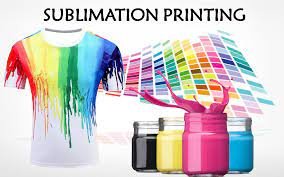The Ultimate Guide to Sublimation Printing: Techniques, Tips, and Best Practices

- Introduction to Sublimation Printing
In the world of graphic design, sublimation printing has become an increasingly popular
technique. This unique printing method allows for vibrant, high-quality prints that are both
durable and long-lasting. Whether you're a seasoned professional or just starting out,
mastering the art of sublimation printing can greatly enhance your designs and set you apart
from the competition. In this ultimate guide, we will explore the techniques, tips, and best
practices for achieving stunning results with sublimation printing. So, if you're ready to take
your graphic design skills to the next level, keep reading!
2. Understanding the Techniques of Sublimation Printing
To achieve the best results with sublimation printing, it is essential to have a solid
understanding of the various techniques involved. From heat press settings to color
management, each step plays a crucial role in the final outcome of your prints.
One important technique to master is proper heat press settings. The temperature and time
you set on your heat press machine can significantly impact the color vibrancy and durability
of your prints. Experiment with different settings to find the optimal combination for your
specific materials and designs.
Another key technique is color management. Sublimation printing relies on accurate color
representation, so ensure that your monitor is calibrated and your design files are saved in
the appropriate color space. Regularly calibrating your equipment will help maintain
consistency and produce accurate colors across different mediums.
By understanding and honing these techniques, you'll be well on your way to creating
stunning sublimation prints that will impress your clients and set you apart in the world of
graphic design. Stay tuned for our next blog section where we'll dive into some handy tips to
elevate your sublimation printing even further!
3. Tips for Successful Sublimation Printing
Now that you have a solid understanding of the various techniques involved in sublimation
printing, it's time to take your prints to the next level with some handy tips. These tips will help
you achieve even better results and ensure a smooth and successful printing process.
Firstly, it's important to prepare your blank substrates properly. Make sure they are clean and
free from any dust or debris before applying the sublimation transfer. Any impurities on the
surface can affect the final print quality.
Secondly, consider using a protective heat-resistant sheet or parchment paper on top of your
substrate before applying heat. This will prevent any unwanted transfer or bleeding of colors,
especially when dealing with products that have a coated or glossy finish.
Thirdly, pay attention to the drying time for your prints. It is crucial to allow enough time for
the ink to fully dry and set before handling or packaging the finished product. This will prevent
any smudging or smearing of the design.
Lastly, always perform test prints before doing a large production run. This will allow you to
spot any potential issues and make any necessary adjustments before wasting valuable
materials.
By following these tips, you can enhance the quality and efficiency of your sublimation
printing and produce exceptional results that will leave a lasting impression on your clients.
Stay tuned for our next blog section where we'll discuss the best practices for sublimation
printing!
4. Best Practices for Sublimation Printing
In order to achieve the best possible results with sublimation printing, there are several best
practices you should follow. These practices will not only improve the quality of your prints
but also help you streamline your printing process.
Firstly, it's important to maintain a clean and organized workspace. This ensures that dust
and debris don't find their way onto your substrates or transfer paper, which can affect the
final outcome. Regularly clean your printer, heat press, and work area to minimize the risk of
contamination.
Secondly, invest in high-quality sublimation inks and transfer paper. These components play a
crucial role in the printing process and can greatly impact the vibrancy and longevity of your
prints. Don't compromise on the quality of these materials as they directly affect the final
result.
Thirdly, calibrate your printer regularly. This ensures that your prints accurately match the
colors in your image files. Calibration also helps you optimize the performance of your
printer, resulting in consistent and accurate prints.
Moreover, ensure that you use the correct heat and pressure settings on your heat press.
Every substrate requires specific temperature and pressure settings for optimal sublimation.
Refer to the manufacturer's guidelines to determine the correct settings for each type of
substrate you work with.
Additionally, properly time your prints and heat press applications. Too little time can result in
incomplete sublimation, while too much time can lead to color bleeding and dull prints.
Experiment and find the ideal duration for each particular substrate and design to achieve the
best results.
Finally, consider investing in a color management system. This system allows you to
accurately measure and control color throughout the printing process, ensuring consistent
and accurate results. It can be particularly useful when working on larger orders or when
color accuracy is crucial.
By implementing these best practices, you can significantly improve the quality and efficiency
of your sublimation printing. Stay tuned for our next blog section, where we'll explore some
creative ideas and inspiration for sublimation printing projects!
5. Choosing the right materials for Sublimation Printing
In the world of sublimation printing, choosing the right materials is essential for achieving the
best results. The materials you select can have a significant impact on the overall quality and
durability of your prints.
When it comes to substrates, there is a wide range of options available. Some popular choices
include ceramic mugs, polyester fabrics, aluminum panels, and phone cases. It's important to
consider the specific characteristics of each substrate, such as its texture, size, and shape, as
these factors can affect the sublimation process. Make sure to select substrates that are
compatible with sublimation printing and have a smooth, even surface to ensure the best
possible results.
In addition to substrates, the choice of transfer paper is equally important. There are different
types of transfer papers available, including light and dark transfer papers. Light transfer
papers are designed for use with light-colored substrates, while dark transfer papers are used
for dark-colored substrates. Be sure to use the appropriate transfer paper for your specific
project to achieve vibrant and accurate prints.
Furthermore, consider the quality and compatibility of sublimation inks with your printer.
High-quality sublimation inks are formulated to produce vibrant and long-lasting prints. It's
essential to choose inks that are compatible with your specific printer model to ensure
optimal printing performance.
When selecting materials for sublimation printing, it's crucial to research and experiment to
find the best combination that suits your needs. Consider factors such as cost, durability, and
the specific requirements of your projects. By carefully choosing the right materials, you can
enhance the quality of your prints and take your sublimation printing to the next level.
Stay tuned for our next blog section, where we'll dive into advanced techniques and
troubleshooting tips to help you overcome common challenges in sublimation printing!
6. Maximizing the lifespan of sublimated prints
Once you've invested in the right materials and perfected your sublimation printing
technique, it's important to consider how to maximize the lifespan of your prints. By taking
proper care of your sublimated products, you can ensure that they maintain their vibrant
colors and durability over time.
One of the key factors in preserving sublimated prints is proper washing and handling. It's
crucial to follow the manufacturer's instructions for washing and drying each specific
substrate. In general, it's recommended to use mild detergent and wash your sublimated
items in cold water. Avoid using bleach or harsh chemicals, as they can fade the colors of your
prints.
Additionally, take extra care when handling and storing sublimated products. Avoid sharp
objects or rough surfaces that could scratch or damage the prints. Consider using protective
sleeves or packaging to prevent any potential damage during transportation or storage.
Another important factor to consider is exposure to direct sunlight. Over time, prolonged
exposure to sunlight can cause fading of sublimated prints. To protect your prints, consider
displaying them in areas away from direct sunlight, or use UV-protected glass or frames to
preserve their colors.
By following these simple tips, you can ensure that your sublimated prints remain vibrant and
visually appealing for a longer period of time. Taking care of your prints not only enhances
their longevity but also reflects your professionalism and commitment to delivering high-
quality products to your customers.
In our next blog section, we'll delve into the world of color management and how to achieve
accurate and consistent colors in your sublimation prints. Stay tuned to learn more!
7. Troubleshooting common issues in Sublimation Printing
In our previous section, we discussed how to maximize the lifespan of your sublimated prints
by taking proper care of them. Now, let's delve into troubleshooting common issues that may
arise during sublimation printing.
1. Fading or washed-out colors: If your prints are coming out with faded or washed-out colors,
the issue may lie in the temperature or pressure settings of your heat press. Ensure that
you're following the manufacturer's recommended settings for the specific substrate you're
using.
2. Blurry or distorted images: Blurriness or distortion in your prints can be caused by low-
resolution or stretched images. Make sure you're using high-resolution images and properly
sizing them before printing.
3. Uneven or patchy prints: Uneven or patchy prints can be a result of improper pressure
distribution or heat distribution in your heat press. Check that your heat press is properly
calibrated and apply consistent pressure during printing.
4. Ghosting or bleeding: Ghosting or bleeding occurs when the ink migrates beyond the
intended printed area. To prevent this issue, ensure that your substrate is completely flat and
that you're using the correct paper and ink for your specific printer and heat press.
By troubleshooting these common issues, you can achieve high-quality sublimation prints
consistently. Next, we'll discuss the different types of substrates that are compatible with
sublimation printing. Stay tuned!
8. Conclusion: Mastering Sublimation Printing for
Professional Results
In conclusion, mastering sublimation printing techniques is essential for achieving
professional results. By following the tips and best practices discussed in this guide, you can
ensure that your prints come out vibrant, sharp, and durable.
Taking proper care of your sublimated prints, troubleshooting common issues, and
understanding the different types of substrates compatible with sublimation printing will give
you the tools you need to produce high-quality products consistently.
Remember to always follow the manufacturer's recommendations for temperature, pressure,
and time settings, and use high-resolution images that are properly sized to avoid blurriness
or distortion. Maintaining proper pressure distribution, heat distribution, and utilizing the
correct paper and ink will prevent issues such as fading or ghosting.
With practice and attention to detail, you can become an expert in sublimation printing and
create stunning products that will impress your clients and customers. Now, go ahead and
unleash your creativity with sublimation printing!

















